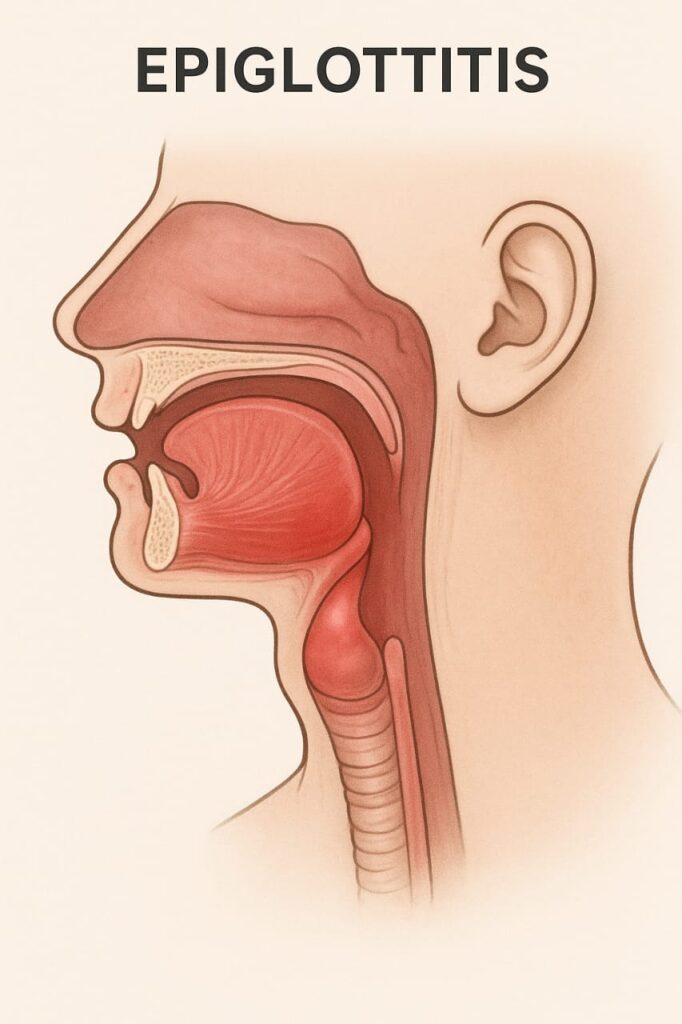Epiglottitis: Causes, Symptoms, Diagnosis, Treatment, and Prevention
Epiglottitis is a rare but potentially life-threatening medical condition that affects the epiglottis, a flap of tissue located at the base of the tongue. The main role of the epiglottis is to prevent food and liquid from entering the windpipe (trachea) when swallowing. However, when this tissue becomes swollen and inflamed, it can block the airway, making it difficult or even impossible to breathe.

What is Epiglottitis?
Epiglottitis is the inflammation and swelling of the epiglottis, usually caused by an infection, injury, or other medical condition. The swelling can become so severe that it blocks airflow into the lungs, leading to respiratory distress.https://en.wikipedia.org/wiki/Epiglottitis
Anatomy
- To better understand epiglottitis, let’s briefly look at the anatomy:
- The epiglottis is a leaf-shaped flap of cartilage covered with mucous membrane.
- It sits at the entrance of the larynx (voice box).
- When swallowing, the epiglottis folds down to cover the trachea, directing food and liquid into the esophagus.
- When breathing, it remains upright, allowing air to flow into the lungs.
- Any swelling or inflammation here is dangerous because even slight enlargement can block airflow.
Causes
- Bacterial Infections (Most Common)
- Haemophilus influenzae type b (Hib): The leading cause in children before the Hib vaccine was introduced.
- Streptococcus pneumoniae and Streptococcus pyogenes can also cause epiglottitis.
- Staphylococcus aureus, including MRSA strains, may also be responsible.
- Viral Infections
- Varicella-zoster virus (chickenpox)
- Herpes simplex virus
- Influenza virus
- Fungal Infections
- Rare but possible in immunocompromised patients.
- Trauma or Injury
- Burns from hot liquids, foods, or steam inhalation.
- Direct injury to the throat, such as a foreign body or sharp object.
- Allergic Reactions
- Severe allergic responses can cause sudden epiglottis swelling.
- Non-infectious Causes
- Drug reactions
- Inhalation of toxic substances
- Smoking and chronic irritation
Risk Factors
- Children aged 2–6 years (though much less common today due to Hib vaccination).
- Unvaccinated children (especially those without Hib vaccine).
- Adults with weakened immune systems (HIV/AIDS, cancer, diabetes).
- People with chronic respiratory diseases.
- Individuals exposed to irritants such as smoke or chemicals.
Symptoms
Common Symptoms in Children
- High fever
- Severe sore throat
- Difficulty swallowing (dysphagia)
- Excessive drooling (because swallowing is painful or impossible)
- Stridor (high-pitched breathing sound)
- Hoarse or muffled voice (“hot potato voice”)
- Anxiety and restlessness
- Sitting in a tripod position (leaning forward, mouth open, and tongue out to ease breathing)
Symptoms in Adults
- Severe sore throat
- Pain while swallowing
- Difficulty breathing
- Hoarseness
- Fever and chills
- Stridor in severe cases
- Chest discomfort
Complications
- Airway obstruction (life-threatening emergency)
- Respiratory arrest
- Sepsis (spread of infection in the bloodstream)
- Pneumonia
- Meningitis (if Hib bacteria spread to the brain)
Diagnosis
Diagnostic Methods:
- Physical Examination
- Doctors look for drooling, difficulty breathing, and tripod posture.
- Direct throat examination is usually avoided unless airway support is ready, as it may worsen obstruction.
- Imaging Tests
- Neck X-ray: May show a “thumb sign,” indicating a swollen epiglottis.
- CT or MRI scans: Rarely used in emergencies.
- Laryngoscopy
- Performed in a controlled hospital setting.
- Helps directly visualize the swollen epiglottis.
- Laboratory Tests
- Blood cultures to identify infection.
- Throat swabs in some cases.
Treatment
Emergency Care
- Oxygen therapy
- Immediate hospitalization
- Intubation (inserting a breathing tube into the windpipe) if airway is blocked
- Tracheostomy (surgical opening in the windpipe) if intubation is not possible
Medications
- Antibiotics: Intravenous broad-spectrum antibiotics (e.g., ceftriaxone, cefotaxime).
- Corticosteroids: To reduce inflammation.
- Antipyretics: To manage fever.
- IV fluids: To prevent dehydration.
Supportive Care
- Humidified oxygen
- Continuous monitoring in the ICU
Prevention
- Vaccination
- The Hib vaccine is the most effective way to prevent epiglottitis in children.
- It is usually given at 2, 4, 6, and 12–15 months of age.
- Good Hygiene
- Wash hands regularly.
- Avoid close contact with sick individuals.
- Healthy Lifestyle
- Stop smoking, as it irritates the throat.
- Strengthen the immune system through proper diet and exercise.
- Allergy Management
- People with severe allergies should carry prescribed medications such as epinephrine.
Frequently Asked Questions (FAQs)
- Is epiglottitis contagious?
Yes, the bacterial infections that cause epiglottitis (like Hib or Streptococcus) are contagious, but the condition itself is not. - Can adults get epiglottitis?
Yes, though less common, adults can develop epiglottitis, especially if they have weakened immunity. - How fast does epiglottitis develop?
Symptoms can develop suddenly within hours and worsen rapidly, making it an emergency. - Is epiglottitis preventable?
Yes, vaccination with the Hib vaccine is the best preventive measure. - Can epiglottitis recur?
Rarely, but it can happen if the person is exposed to risk factors or does not receive proper treatment.
ksamdha
